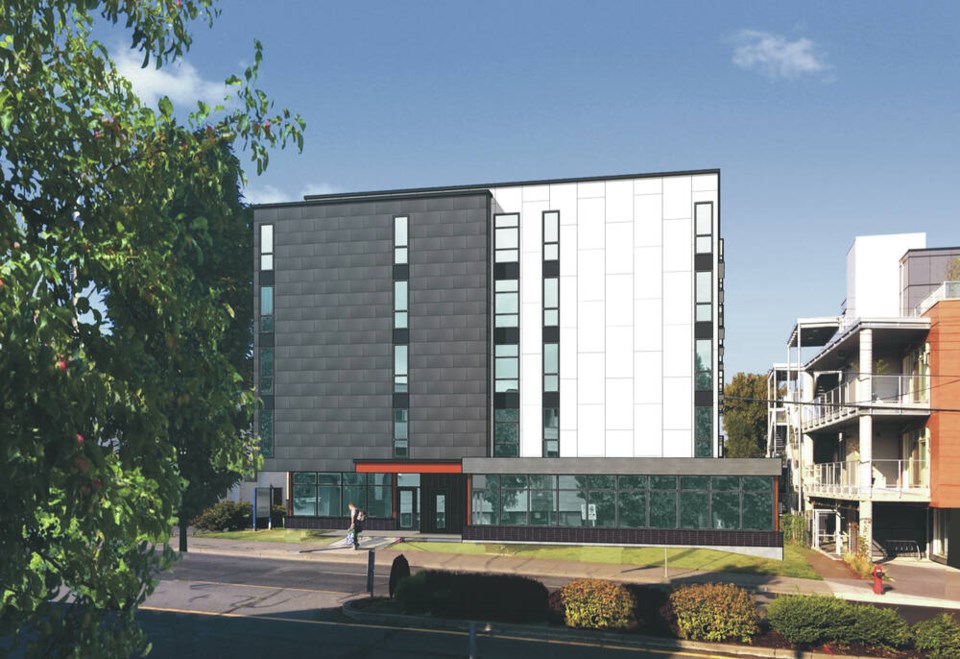A novel approach to workforce housing took a step closer this week when the City of Victoria approved a grant application for $2.5 million to help make a new affordable 40-unit apartment complex a reality.
But it will still be months before the Greater Victoria Housing Society can break ground on the project.
Executive director Virginia Holden said the funding helps the society, which owns and operates 18 properties with 924 units of affordable housing, bridge an equity gap they were struggling with due to high costs and rising interest rates.
But Holden warns she doesn’t expect construction to start until next year at the earliest.
“This is the first step of a cascade of actions,” said Holden, who noted they still have to work out the financing for the $18-million project with Canada Mortgage and Housing Corporation and then work to re-house tenants still living in the building that is to be replaced by the new project.
The five-storey, 40-unit building being planned for 2558 Quadra St. is being designed for workforce housing for the hospitality sector.
It will replace a 19-unit building that is at the end of its life but is still being used to house low-and moderate-income families.
Holden, who hopes to see the demolition of the old building start next year, said the wheels are in motion with the $2.5 million from the city’s Housing Reserve Fund.
Holden said it takes time to get all the pieces in place and all levels of government on board to make an affordable housing project a reality, as they all come with different objectives and outcomes and all require different qualifications from the partners.
“It does take time and it’s wonderful to see cities like Victoria really make building affordable housing and especially non-market housing a priority,” she said, noting Victoria fast-tracks non-market projects.
The workforce housing project may be new to Victoria, but it has been done in places like Whistler and Tofino.
“Whistler has its own housing authority, which is a non-profit of the local government,” Holden said, noting it is focused on building housing for its hospitality workforce. “It’s great to have these destinations, but if you can’t find places for people who work in that industry to live you have real problems.”
She said the Quadra Street project is a win-win as the partnership with Destination Greater Victoria allows the society to access a new funding stream and build housing for low-income workers, while the tourism industry gets housing constructed for some of its workforce.
In a way the grant money is being returned to the hospitality industry.
Since 2021 the city has received $2.8 million from online accommodation platforms like Airbnb and other short-term rental sites.
That same year, the city and Destination Greater Victoria agreed those funds would be put into the housing reserve fund to be used to create affordable workforce housing.
The society and the tourism marketing organization are working out details of a memorandum of understanding about how the tenant selection process will work.
Holden said the building will prioritize hospitality and tourism workers, and they will have to qualify as low- and moderate-income households.
She said this is not a deeply subsidized project so the building will have mixed incomes and rents will not be as low as in some of their other projects.
Holden said if it was built today, the 40-unit building would see 30 per cent set aside as “more affordable” where studio units would rent for about $880 a month and one-bedroom units for $1,000 and two-bedroom for $1,300.
The other 70 per cent of the building would be deemed “affordable market” with studios renting at $1,475, one-bedrooms around $1,750 and two-bedroom units for $1,925.
“These are numbers based on construction today. They could change based on what it takes for us to build a building, and if interest rates go up; these are our preliminary numbers,” she said. “Now that doesn’t sound super affordable. But here’s what I call the secret sauce of non-profit housing — we don’t increase the rents.”
She said they try to deal with covering their costs over time, but said the affordability of those units increases.
“We have a project that we opened in 2015 and at the time the rents were about 80 per cent of market and now they’re at 70 to 60 per cent of market,” she said.
“Building affordable housing is hard. It’s really hard to make the numbers work,” she said, noting since the project was first brought to council for rezoning approval in 2020, the costs have increased 20 per cent.
Holden said she hopes to do more projects like this, and warns the city and province are going to have to get creative to meet the housing need for low-income households given the “desperate shortage.”
“Otherwise, we’re going to see things like homelessness and people leaving our community increase,” she said. “The uplifting note is we’re putting these partnerships together, we’re getting creative. We’re just going to have to do more of it.”



